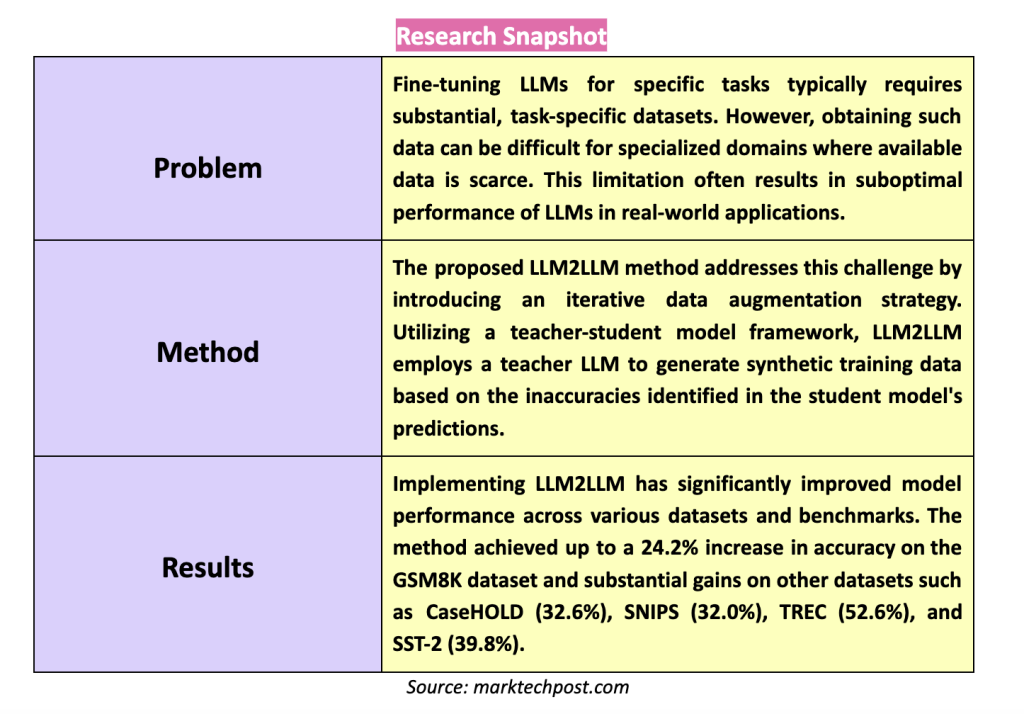Large language models (LLMs) are at the forefront of technological advances in natural language processing and mark a significant leap in the ability of machines to understand, interpret, and generate human-like text. However, the full potential of LLMs often remains untapped due to the limitations imposed by the scarcity of specialized, task-specific training data. This bottleneck restricts the applicability of LLMs in various domains, particularly those that have data constraints.
LLM2LLM is proposed by a research team from UC Berkeley, ICSI and LBNL as an innovative method to amplify the capabilities of LLMs in the low data regime. This approach differs from traditional data augmentation techniques, which typically involve simple manipulations such as synonym replacement or text rephrasing. While these methods can expand the data set, they rarely improve model understanding of complex and specialized tasks. Instead, LLM2LLM uses a more sophisticated iterative process that directly targets a model's weaknesses, creating a feedback loop that progressively refines its performance.
The LLM2LLM methodology is an interactive dynamic between two LLMs: a teacher model and a student model. Initially, the student model is fine-tuned on a limited data set. It is then evaluated to identify cases where it fails to predict accurately. These examples are crucial as they highlight specific areas of weakness in the model. The teaching model steps in at this point, generating new synthetic data points that mimic these challenging cases. This newly created data is then used to retrain the student model, effectively focusing the training process on overcoming its previously identified deficiencies.
What sets LLM2LLM apart is its iterative, targeted approach to data augmentation. Instead of indiscriminately expanding the data set, it intelligently generates new data designed to improve the model's performance on tasks it previously struggled with. In testing on the GSM8K dataset, the LLM2LLM method achieved up to a 24.2% improvement in model performance. Similarly, in the CaseHOLD dataset, there was an improvement of 32.6% and in SNIPS, an increase of 32.0% was observed.

In conclusion, the LLM2LLM framework offers a robust solution to the critical challenge of data scarcity. By harnessing the power of one LLM to improve another, it demonstrates a novel and efficient path to fine-tuning models for specific tasks with limited initial data. The iterative and targeted nature of LLM2LLM significantly outperforms traditional data augmentation and tuning methods, showing its potential to revolutionize the way LLMs are trained and applied.
Review the Paper. All credit for this research goes to the researchers of this project. Also, don't forget to follow us on Twitter. Join our Telegram channel, Discord Channeland LinkedIn Grabove.
If you like our work, you will love our Newsletter..
Don't forget to join our 39k+ ML SubReddit
![]()
Hello, my name is Adnan Hassan. I'm a consulting intern at Marktechpost and soon to be a management trainee at American Express. I am currently pursuing a double degree from the Indian Institute of technology, Kharagpur. I am passionate about technology and I want to create new products that make a difference.
<!– ai CONTENT END 2 –>
 NEWSLETTER
NEWSLETTER





